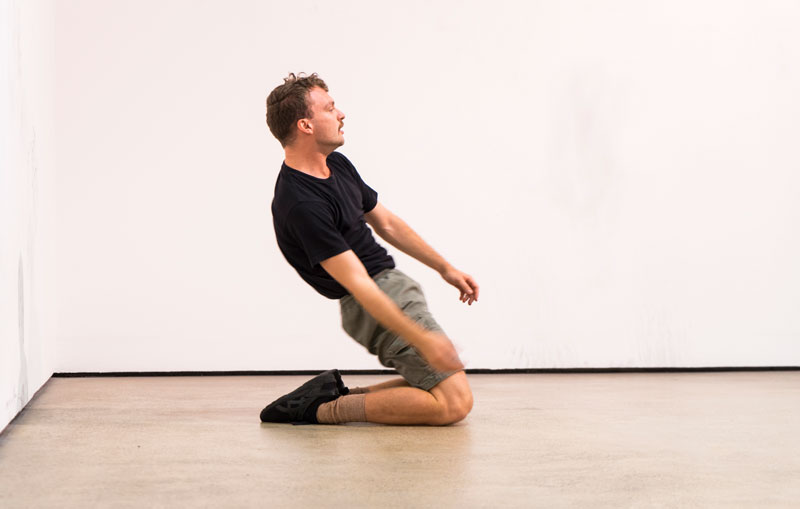
In recent years, exhibitions at the Institute of Modern Art (IMA) have been obsessed with signalling. This continues with the Argentine artist Amalia Pica’s please, open, hurry, which uses video, sound, performance and sculpture to ponder human–animal communication, informed by her studies of nonhuman primates in Nigeria and North America. But, whereas past IMA shows have seemed more preoccupied with systems of display than with the issues purporting to be represented (such as global economics, communal solidarity and precarious labour), Pica’s exhibition cuts through such semantic obsessions, in spite of initial appearances. In asking if animals really do communicate with us—beyond anthropomorphic projection—Pica is also asking if miscommunication might actually be productive, revealing the need for more empathic and intuitive modes of understanding. Guided by posthumanist ideas, Pica isn’t concerned with producing the right kind of language, or the right kind of representational distance, but with what constitutes communication when it is no longer “framed by the ineluctable powers of signification.”[1]
Of course, the relation between humans and animals is fundamental. As Jacques Derrida once claimed, the question of “animality” is no ordinary one; rather, it is the “limit upon which all the great questions are formed and determined, … all the concepts that attempt to delimit what is ‘proper to man,’ the essence and future of humanity, ethics, politics, law, ‘human rights,’ ‘crimes against humanity,’ ‘genocide,’ etc.”[2] This exhibition doesn’t directly address such delineations, but it does suggest art has a role in recognising how preconceptions of the animal as Other inform our thinking about visual culture. A number of Pica’s works highlight humans mimicking animals, animals conforming to human expectations and the shared values of tool-making and symbolic status among hominidae (humans and great ape species). Her interest in relationships – including the scientific study of intersections between distinct sets of data – is a key motivation, but her treatments are normally understated enough to avoid the communal utopian clichés of relational aesthetics, focussing more cautiously on issues of (mis-)classification as communication.
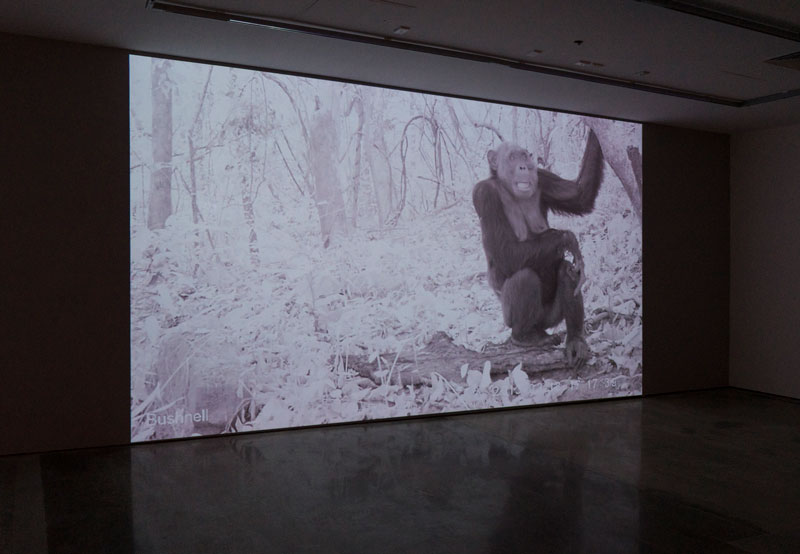
The first work of Pica’s encountered in the IMA is Pan troglodytes ellioti and cousins (2016) – a one-minute looped video projection of a family of chimpanzees in a Nigerian forest, depicted by a sensor-activated night-vision camera that they (mis-)triggered during the day. The chimps congregate as if looking at the viewer, their protracted posing coupled with the washed-out black and white quality of the footage strangely reminding me of nineteenth-century photography. The footage is silent but reverberating from another space is the sound of hollering chimpanzees (Is it grunting, barking or panting? 2017) – one of four pieces in the exhibition Pica has made in collaboration with the filmmaker Rafael Ortega. But what sounds like the primal communication of great apes is really the sound of primatologists mimicking their speech patterns and local dialects. Misrecognitions of this type reoccur throughout. For instance, a monitor adjacent to a motion-sensor camera in the first room does not, as expected, display live footage of IMA viewers but instead shows viewers walking around other galleries, recorded from earlier iterations of the work.
In Pica’s version of a music video, Music for 429 Megaponeras (2017), ants walking in a line along a forest floor each have a number superimposed next to them (429 in total), moving to what sounds like a sprightly minimalist xylophone score in the vein of Steve Reich. Megaponeras are African ants that prey on termites, whose nests they strategically raid using their painful stings. But perhaps what interests the artist most about megaponeras is their relatively sophisticated social structures; they divide their labour between those who break up the nest and those who do the killing, and there are even so-called “paramedic” ants who carry injured co-workers home to heal. Some chimpanzees take the risk of eating megaponeras, employing what is known as “single-use” tools to scoop them up. These are essentially assisted-readymade spoons, one of which Pica has cast in silver, Silverware (2017), and installed on the wall like a Duchampian trophy.
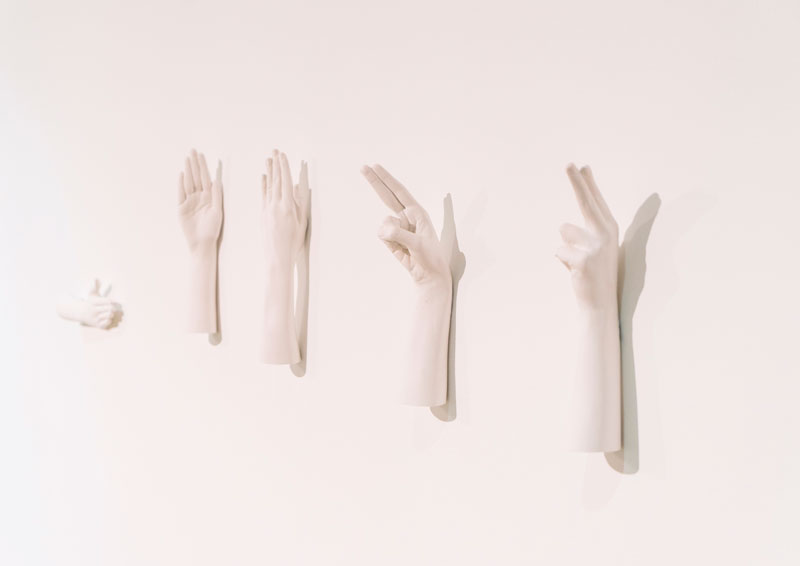
The exhibition’s title, please, open, hurry, sounds like a politely panicked Morse code message, but it is actually a reference to Washoe, a female chimpanzee who was captured as a baby in West Africa in 1966 by the American government to be studied for space program research. Instead, she was raised by primatologists who spent years teaching her sign language. When her carer and educator Roger Fouts – a friend and colleague of Jane Goodall – arrived in the morning, Washoe would sign for him to please hurry up and let her out to play. By the time she died at the age of 42, Washoe had learnt over 240 signs, and she is still recognised as one the most convincing examples of non-humans being capable of complex language acquisition.
In please, open, hurry (in memory of Washoe) (2018) casts of human arms spelling out the title of the exhibition in sign language are installed directly on a gallery wall. The work recalls Bruce Nauman’s bronze hand casts, Fifteen Pairs of Hands (1996). But while Nauman’s presents a sort of graceful dismemberment – echoing Théodore Géricault’s Study of Feet and Hands (1818–19) – Pica’s are more sentimental; she understates the work’s physicality to connote spirituality, resembling the manicured hands of Flemish Renaissance artists such as Jan Gossaert.
Pica is at her best when her studies of communication systems are underscored by a futility that recalls the work of Buster Keaton, Samuel Beckett and even her fellow Argentine Jorge Borges. This can be seen in earlier pieces such as Playing solo and indoors (mechanical jump rope) (2013), which comprises a cumbersome steel mechanical contraption moving a skipping rope around monotonously, doubling as a stage for performers to recount their daily errands in detail as they jump. A similar pointlessness is in Babble, Blabber, Chatter, Gibber, Jabber, Patter, Prattle, Rattle, Yammer, Yada Yada Yada (2010), which consists of slides of Pica in a desert-like landscape using semaphore flags to spell out the title of the work.
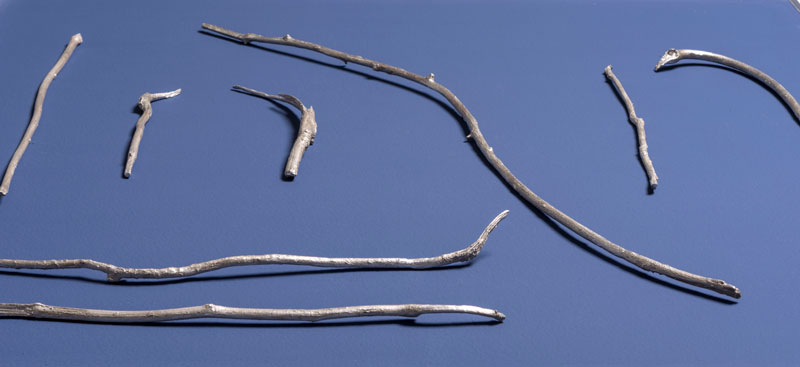
There are moments like these in the 13-minute video Catalogue of great ape gestures (in alphabetical order) (2018). The work, recorded at the IMA, shows local Brisbane dancer Michael Smith reinterpreting a compilation of great ape gestures published by researchers at the University of St. Andrews, Scotland. Although great ape gestural repertoires are large when compared with other animals, due to the relatively small number of intended meanings they appear to achieve, there are extensive overlaps in their significance. This interpretive potential is pounced on by Pica as an excuse for interpretive collaboration. Smith performs, with his own flare, the St. Andrews gestures in alphabetical order, hinting at a shared love of artistic ambiguity between humans and great apes. Concentrating his actions in one corner of the gallery space, Smith’s unconsciously produced dirty marks on the wall have been left to look like primitive gestures. Although not credited as an actual work, they point to issues of illocutionary intention in communication, asking whether there might be such a thing as a language of mute, unintentional traces.
Situated adjacent to Smith’s gestural dancing, the large white book-like sculpture, Yerkish (2018), was modelled on a pictorial system used to test the linguistic potential of nonhuman primates. The scaled-up nature of the work hints at the impositions of the actual tests, as well as the constant testing, classifying and, for want of a less paradoxical term, “dehumanizing” involved in scientific studies of the animal world. At the same time, the work nods to the sometimes-mysterious language of art itself, evoking the sheer strangeness of minimal and post-minimal objects when they first came on the scene, from Robert Morris’s L-Beams to Matt Mullican’s idiosyncratic cosmology symbols.

The emphasis on research, and on detailed historical narratives, puts please, open, hurry firmly within the scope of Hal Foster’s 2004 essay An Archival Impulse. Here, Foster describes a range of artists who want to make physically present historical information thought to be lost or obscured by the 24/7 information of the now. He noted how many of these artists, such as Tacita Dean and Gerard Byrne, treat their histories in non-linear ways, to the extent that their archival compilations might be undoing the very repute of such repositories of knowledge.[3] Finding poetry in the programmatic, and seeing rhizomes in rigorous systems, Pica’s work fits with Foster’s thesis, but she has also spoken of other art-historical precedents for her work. This includes the “designed participation” aesthetics of the Brazilian movement Tropicália, whose artists, along with a host of other 1960s minimalist-conceptualists, were far more motivated by “irrational” forces than they have been given credit for.
Language abounds in this exhibition yet I can’t help thinking that Pica is more interested in larger issues to do with art’s role in revealing the limits of human knowledge. Art is treated as anti-explanatory in spite of the detailed contextual frames that support each work, which is something Pica was almost comically apologetic for when I talked with her before the show. Walking around the exhibition, I thought of Sol Lewitt’s off-handed remarks at the start of his famous 1967 essay, “Paragraphs on Conceptual Art,” published in Artforum. Lewitt states how the editor has asked him to write unapologetically in his own artistic voice because he doesn’t subscribe to the idea of the artist as “a kind of ape that has to be explained by the civilized critic.”[4] Pica’s exhibition zeroes in on such unconscious analogies, finding in human–animal communication traces of Lewitt’s own validation of the pleasures of “misconstrual.”
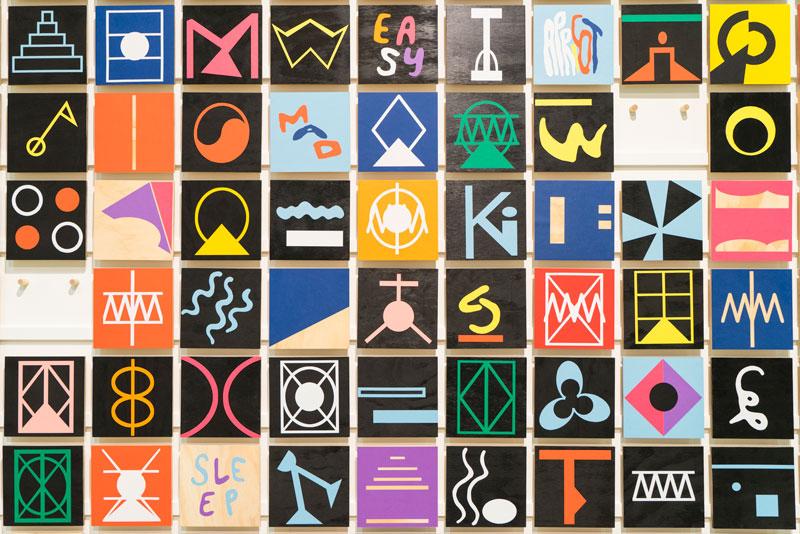
Footnotes
- ^ Rosi Braidotti, “Posthuman Critical Theory,” in D Banerji and M. R. Paranjape (eds), Critical Posthumanism and Planetary Futures, 2016, p. 24.
- ^ Jacques Derrida, “Violence Against Animals,” For What Tomorrow, Stanford: Stanford University Press, 2004, pp. 61–62.
- ^ Hal Foster, “An Archival Impulse,” October 110, Autumn, 2004, pp. 3–22.
- ^ Sol Lewitt, “Paragraphs on Conceptual Art,” Artforum, no. 10, Summer 1967, pp. 79–83.

